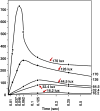Metacontrast masking and the cortical representation of surface color: dynamical aspects of edge integration and contrast gain control
- PMID: 20517518
- PMCID: PMC2864963
- DOI: 10.2478/v10053-008-0034-z
Metacontrast masking and the cortical representation of surface color: dynamical aspects of edge integration and contrast gain control
Abstract
This paper reviews recent theoretical and experimental work supporting the idea that brightness is computed in a series of neural stages involving edge integration and contrast gain control. It is proposed here that metacontrast and paracontrast masking occur as byproducts of the dynamical properties of these neural mechanisms. The brightness computation model assumes, more specifically, that early visual neurons in the retina, and cortical areas V1 and V2, encode local edge signals whose magnitudes are proportional to the logarithms of the luminance ratios at luminance edges within the retinal image. These local edge signals give rise to secondary neural lightness and darkness spatial induction signals, which are summed at a later stage of cortical processing to produce a neural representation of surface color, or achromatic color, in the case of the chromatically neutral stimuli considered here. Prior to the spatial summation of these edge-based induction signals, the weights assigned to local edge contrast are adjusted by cortical gain mechanisms involving both lateral interactions between neural edge detectors and top-down attentional control. We have previously constructed and computer-simulated a neural model of achromatic color perception based on these principles and have shown that our model gives a good quantitative account of the results of several brightness matching experiments. Adding to this model the realistic dynamical assumptions that 1) the neurons that encode local contrast exhibit transient firing rate enhancement at the onset of an edge, and 2) that the effects of contrast gain control take time to spread between edges, results in a dynamic model of brightness computation that predicts the existence Broca-Sulzer transient brightness enhancement of the target, Type B metacontrast masking, and a form of paracontrast masking in which the target brightness is enhanced when the mask precedes the target in time.
Keywords: achromatic color; brightness; brightness induction; edge integration; lightness; masking; metacontrast; paracontrast; type B masking.
Figures





Similar articles
-
A cortical edge-integration model of object-based lightness computation that explains effects of spatial context and individual differences.Front Hum Neurosci. 2014 Aug 22;8:640. doi: 10.3389/fnhum.2014.00640. eCollection 2014. Front Hum Neurosci. 2014. PMID: 25202253 Free PMC article.
-
Edge integration in achromatic color perception and the lightness-darkness asymmetry.J Vis. 2013 Dec 26;13(14):18. doi: 10.1167/13.14.18. J Vis. 2013. PMID: 24370541
-
Stevens's brightness law, contrast gain control, and edge integration in achromatic color perception: a unified model.J Opt Soc Am A Opt Image Sci Vis. 2007 Sep;24(9):2766-82. doi: 10.1364/josaa.24.002766. J Opt Soc Am A Opt Image Sci Vis. 2007. PMID: 17767246
-
Cortical dynamics of lateral inhibition: metacontrast masking.Psychol Rev. 1997 Jul;104(3):572-94. doi: 10.1037/0033-295x.104.3.572. Psychol Rev. 1997. PMID: 9243965 Review.
-
Lightness, filling-in, and the fundamental role of context in visual perception.Prog Brain Res. 2006;155:109-23. doi: 10.1016/S0079-6123(06)55007-1. Prog Brain Res. 2006. PMID: 17027383 Review.
Cited by
-
Visual masking and the dynamics of human perception, cognition, and consciousness A century of progress, a contemporary synthesis, and future directions.Adv Cogn Psychol. 2008 Jul 15;3(1-2):1-8. doi: 10.2478/v10053-008-0009-0. Adv Cogn Psychol. 2008. PMID: 20517493 Free PMC article.
References
-
- Agostini T., Bruno N. Lightness contrast in CRT and paper-and-illuminant displays. Perception & Psychophysics. 1996;58:250–258. - PubMed
-
- Aiba T. S., Stevens S. S. Relation of brightness to duration under light- and dark-adaptation. Vision Research. 1964;4:391–401. - PubMed
-
- Alpern M. Metacontrast: historical introduction. American Journal of Optometry. 1952;29:631–646. - PubMed
-
- Alpern M. Metacontrast. Journal of the Optical Society of America. 1953;43:648–657. - PubMed
-
- Alpern M. Simultaneous brightness contrast for flashes of different durations. Investigative Ophthalmology. 1963;2:47–54. - PubMed
LinkOut - more resources
Full Text Sources
